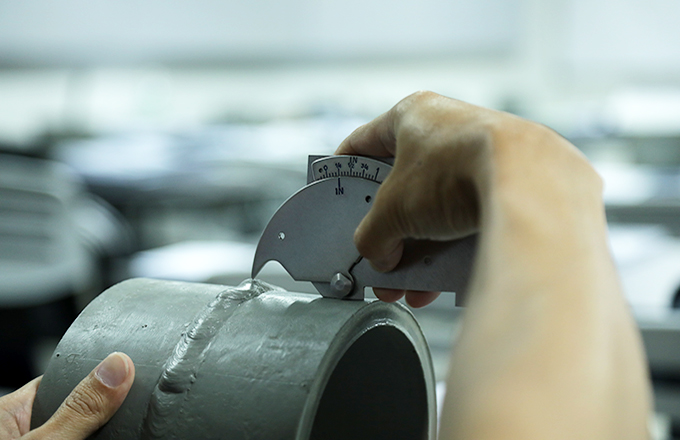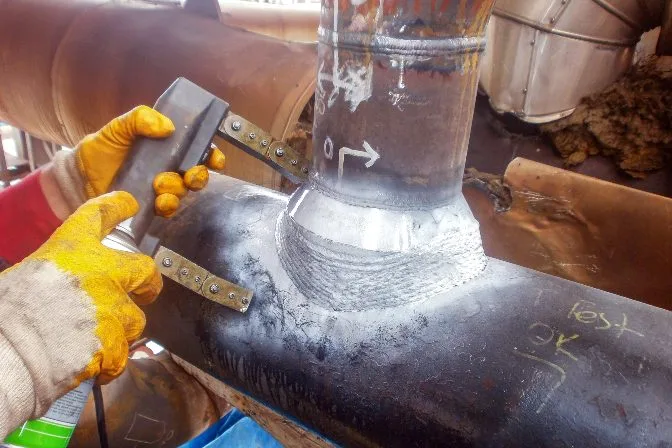The Crucial Role of Welding Inspection: Understanding the Treatments, Equipment, and Requirement That Govern High Quality Assessment in Welding Procedures
Welding examination is an essential component of high quality guarantee in welding procedures, making certain the structural stability and safety and security of welded settings up. Comprehending the interaction in between examination approaches and regulatory compliance raises vital concerns regarding the obstacles encountered in preserving these important procedures.
Relevance of Welding Inspection
Welding inspection is essential in making certain the honesty and safety and security of bonded structures, as it frequently serves as the final checkpoint before elements are put into service. The importance of this examination hinges on its ability to identify potential issues that may endanger the efficiency and durability of welded joints. Provided the high stakes involved, specifically in sectors such as building, aerospace, and vehicle, complete assessment procedures are essential.
Welding issues can emerge from different aspects, consisting of incorrect techniques, poor devices, or unsuitable products. Failing to discover these issues can bring about disastrous repercussions, consisting of structural failures, which might result in injury, death, and substantial economic responsibilities. Welding assessment offers an organized method to evaluate the top quality of welds, making sure compliance with market criteria and regulatory needs.
Furthermore, reliable welding inspection adds to enhancing general performance by reducing rework and making certain that projects stay on schedule. By promoting a society of quality control, companies can additionally increase their track record and customer count on. Fundamentally, the relevance of welding assessment can not be overemphasized, as it plays a critical function in guarding both human lives and financial investments in infrastructure.
Key Evaluation Treatments
A thorough approach to evaluation procedures is necessary for making certain the quality and dependability of welded joints. Efficient assessment begins with pre-weld assessments, which include evaluating welding specs, product residential or commercial properties, and joint designs to identify potential challenges. This preparation stage develops a standard for high quality expectations.
During the welding process, in-process inspections are crucial. Examiners keep track of parameters such as warmth input, traveling speed, and electrode angle to guarantee compliance with established criteria. Aesthetic evaluations are the first line of protection, making it possible for the recognition of surface defects, such as splits, porosity, or insufficient fusion.
Post-weld inspections entail advanced strategies to examine the stability of the joint. This may consist of non-destructive screening (NDT) methods such as ultrasonic screening, radiographic screening, or magnetic particle screening. These methods provide much deeper insights right into the interior framework of the weld, exposing potential problems that may not show up externally.
Documents plays an indispensable role throughout the examination process. Thorough records of examinations, including searchings for and restorative activities, make sure traceability and accountability, inevitably adding to continuous enhancement in welding methods and total quality control.
Vital Tools for Evaluation
Reliable inspection depends on the usage of specialized devices developed to assess the top quality and integrity of welded joints. Secret tools in this procedure consist of aesthetic evaluation tools, such as multiplying borescopes and glasses, which allow inspectors to determine surface area flaws and abnormalities. Additionally, ultrasonic testing (UT) equipment plays a vital duty by making use of high-frequency sound waves to spot interior problems within welds, making sure that concealed weak points are determined prior to they cause failing.
Radiographic see this screening (RT) is one more necessary approach, making use of X-rays or gamma rays to generate photos of the welds, exposing interior problems that may not show up through other evaluation techniques - Houston Welding Inspection. Magnetic particle testing (MT) is employed for ferromagnetic products, permitting inspectors to locate surface area and near-surface issues by using electromagnetic fields and great bits
Dye penetrant screening (PT) is likewise substantial, including the application of a fluorescent color to expose surface area fractures and suspensions. Each of these techniques and tools adds to a detailed inspection strategy, making sure that welded frameworks meet the needed quality requirements and continue to be safe for usage in their respective applications.

Market Requirements and Regulations
Quality control in welding assessment is dramatically affected by industry criteria and regulations that govern practices and guarantee security. These requirements work as criteria for high quality, outlining the required protocols for inspection, documentation, and screening. Key companies such as the American Welding Culture (AWS), the American Culture of Mechanical Engineers (ASME), and the International Company for Standardization (ISO) develop this article guidelines that welding professionals have to follow throughout the assessment process.
Conformity with these requirements is not only an issue of regulatory commitment yet likewise a crucial part of danger management in welding procedures. They include various facets, including product choice, welding strategies, and qualifications of workers. AWS D1.1 describes architectural welding requirements, while ISO 3834 defines quality demands for welding processes.
Additionally, industry guidelines determine the required credentials for welding inspectors, requiring certifications that verify their proficiency. This positioning with criteria guarantees that examinations are performed constantly and properly, ultimately protecting the honesty of bonded structures. Following these sector standards and policies is vital in advertising operational efficiency and preserving public depend on in welding techniques.
Obstacles in Welding Inspection


Welding inspection encounters various challenges that can impact the integrity and safety and security of welded structures. One significant obstacle is the intricacy of the welding processes themselves, which can differ substantially relying on materials, joint configurations, and environmental conditions. This irregularity requires a complete understanding of diverse assessment strategies and their suitable applications.
Another difficulty hinges on the progressing nature of welding innovation. As brand-new materials and techniques are introduced, examiners must constantly update their understanding and abilities to successfully assess the top quality of welds. Additionally, the physical access of weld locations can prevent evaluation initiatives, particularly in restricted or risky environments.
Moreover, human factors play a critical duty in welding assessment. Houston Welding Inspection. The subjective nature of visual assessments can bring about disparities, as different assessors might interpret the exact same weld in different ways. This emphasizes the significance of standard training and qualification for inspectors to guarantee an uniform technique to top quality analysis
Lastly, the integration of advanced innovations, such as automated assessments and expert system, presents both possibilities and challenges. While these technologies can improve accuracy and efficiency, they likewise need significant financial investment and knowledge to carry out successfully. Attending to these difficulties is vital for preserving the stability of welded structures.
Conclusion
Welding inspection is essential for guaranteeing the safety and view security and stability of bonded structures. Inevitably, a robust welding examination framework not just assures compliance with laws but also boosts overall operational effectiveness and integrity. Houston Welding Inspection.
Welding evaluation is an essential part of quality assurance in welding procedures, ensuring the structural stability and safety and security of welded assemblies.Welding assessment is crucial in guaranteeing the stability and safety and security of bonded structures, as it frequently serves as the last checkpoint prior to parts are placed into service. Welding evaluation supplies an organized strategy to evaluate the quality of welds, making sure conformity with industry standards and governing requirements.
Quality assurance in welding evaluation is substantially affected by market requirements and guidelines that regulate methods and make sure safety and security. Trick companies such as the American Welding Culture (AWS), the American Society of Mechanical Engineers (ASME), and the International Company for Standardization (ISO) develop standards that welding experts should adhere to throughout the evaluation process.
Comments on “Affordable Houston Welding Inspection Services for Your Building Requirements”